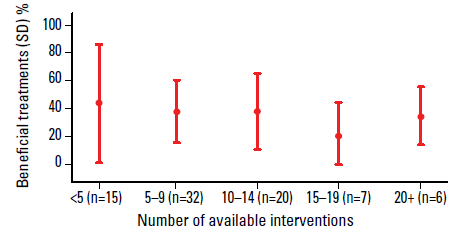We decided to test this aphorism by establishing a set of conditions for which there are treatments classified by evidence of effectiveness. Clinical Evidence, from the British Medical Journal’s stable of publications, seemed to fit the bill well.2 It is a database of evidence based systematic overviews of the benefits and harms of treatments for many of the conditions encountered in primary care, using a transparent process of determining the level of evidence for each (Figure 1).
Method
We generated a random list of numbers in a spreadsheet program to select 80 conditions from Clinical Evidence. For each condition we counted the number of beneficial, or likely to be beneficial, interventions and the total number of interventions. We then calculated the proportion of interventions that were beneficial (or ‘sufficient’, in the aphorism) for each of these conditions.
We tested whether the aphorism was true statistically by attempting to reject the hypothesis that the proportion of beneficial treatments would be, on average, the same over all conditions, irrespective of the number of available treatments. The statistical test we used was negative binomial regression.
Results
For the selected conditions, the overall proportion of beneficial treatments was 34%. This was the same as the proportion of beneficial/likely beneficial treatments for all the conditions in Clinical Evidence, suggesting that our random sampling was successful. Some conditions have many treatments available with a high proportion of them beneficial (such as ‘nonmetastatic breast cancer’ and ‘constipation in adults’). Others had few treatments available, yet they were beneficial (such as ‘bacterial conjunctivitis’). Plotting the proportion that were beneficial against the number of treatments for each yielded a mean proportion beneficial that ranged from 20% (for 15–19 treatments) to 44% (<5 treatments). Our results are consistent with a constant percentage of beneficial conditions over all conditions (p=0.12 for rejecting null hypothesis from negative binomial regression) (Figure 2).

Figure 2. The mean number of beneficial treatments by the number of available interventions
Discussion
This sample of conditions does not support the aphorism ‘If many treatments are used for a disease, all are insufficient’. Were our methods faulty? We took care to use common conditions with rigorously tested treatments. What would explain the failure of the aphorism? When Osler was writing (over 120 years ago), there were very few treatments and far fewer that were beneficial. Perhaps as medical science has progressed and more treatments have become available, disproportionately more are effective.
Conflict of interest: none declared.